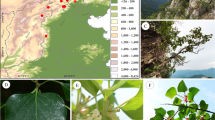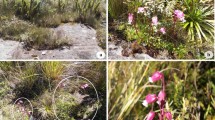Abstract
The Cactaceae are known to be amongst the most endangered plant families of the world due to reduction of their habitats and activities of collectors. As the species of the family are dependent on animals to perform cross pollination, and hence seed production, their population performance may be further negatively affected by interrupted biotic interactions. For efficient conservation of rare species, knowledge on reproductive biology and pollinators is of prime importance. In our study we focused on Uebelmannia buiningii Donald, a microendemic cactus from the Serra Negra State Park, Minas Gerais state, Brazil. During four field expeditions to three localities of the species between September 2012 and September 2013, we measured flowers, detected nectar-guides and osmophores and performed pollen viability tests. We studied the reproductive system of the species using manual self- and cross-pollination tests and observed pollinators. Our results revealed that the flowering period takes place during the dry season, between April and October, and that the diurnal flowers open between 7:00 a.m. and 5 p.m. The flowers are shortly tubular with yellow perianth-segments. We found neither nectar nor nectar-guides, and osmophores appeared as glands within the flower tube. Whereas pollen viability was 90.25%, manual cross-pollination tests have shown cross-pollination with gametophytic incompatibility. We observed two bee species visiting the flowers and acting as effective pollinators: Dialictus opacus and Plebeia sp. The combination of low reproductive activity with gametophytic incompatibility, together with the reduced number of individuals in a population and low number of populations, makes the endemic cactus U. buiningii a critically endangered species.





Similar content being viewed by others
References
Aona LYS, Machado M, Pansarin ER, de Castro CC, Zappi D, do Amaral MCE (2006) Pollination biology of three Brazilian species of Micranthocereus Backeb. (Cereeae, Cactoideae) endemic to the “campos rupestres”. Bradleya 24:39–52
BFG (Brazil Flora Group) (2015) Growing knowledge: an overview of seed plant diversity in Brazil. Rodriguésia 66:1085–1113
Biesmeijer JC, Slaa J (2006) The structure of eusocial bee assemblages in Brazil. Apidologie 37:240–258
Boyle TH (2003) Identification of self-incompatibility groups in Hatiora and Schlumbergera (Cactaceae). Sex Pl Reprod 16:151–155
Colaço MAS, Fonseca RBS, Lambert SM, Costa CBN, Machado CG, Borba EL (2006) Biologia reprodutiva de Melocactus glaucescens Buining & Brederoo e M. paucispinus G. Heimen & R. Paul (Cactaceae), na Chapada Diamantina, Nordeste do Brasil. Revista Brasil Bot 29:239–249
Conceição AA (2006) Plant ecology in ‘Campos Rupestres’ of the Chapada Diamantina, Bahia. In Queiroz LP, Rapini A, Giulietti AM (Org). Towards greater knowledge of the Brazilian semi-arid biodiversity. Ministério da Ciência e Tecnologia, Brasília. pp 63–67
Cruden RW (1977) Pollen-Ovule ratios: a conservative indicator of breeding systems in flowering plants. Evolution 31:32–46
Dafni A (1992) Pollination ecology: a practical approach. Oxford University Press, Oxford, England
Fleming TH, Holland JN (1998) The evolution of obligate pollination mutualisms: senita cactus and senita moth. Oecologia 114:368–375
Fonseca RBS, Funch LS, Borba EL (2008) Reproductive phenology of Melocactus (Cactaceae) species from Chapada Diamantina, Bahia, Brazil. Revista Brasil Bot 31:237–244
Forzza RC, Baumgratz JFA, Bicudo CEM, Canhos DAL, Carvalho Jr AA, Coelho MAN, Costa AF, Costa DP, Hopkins MG, Leitman PM, Lohmann LG, Nic Lughadha E, Maia LC, Martinelli G, Menezes M, Morim MP, Peixoto AL, Pirani JR, Prado J, Queiroz LP, Souza S, Souza VC, Stehmann JR, Sylvestre LS, Walter BMT, Zappi DC (2012) New Brazilian floristic list highlights conservation challenges. BioScience 62:39–45
Gaston KJ (1994) Rarity. Chapman & Hall, London
Gitzendanner MA, Soltis PS (2000) Patterns of genetic variation in rare and widespread plant congeners. Amer J Bot 87: 783–792
Giulietti AM, Pirani JR (1988) Patterns of geographic distribution of some plant species from the Espinhaço Range, Minas Gerais and Bahia, Brazil. In Vanzolini PE, Heyer WR (Org.). Proceedings of a workshop on Neotropical distribution patterns. Academia Brasileira de Ciências, Rio de Janeiro, pp 39–69
Giulietti AM, Pirani JR (1997) Espinhaço Range Region: Eastern Brazil. In Davis SD, Heywood VH, Herrera-Macbride O, Villa-Lobos J, and Hamilton AC (eds). Centres of plant diversity: a guide and strategy for their conservation, Information Press, Oxford, UK. pp 397–404
Goettsch B, Hilton-Taylor C, Cruz-Piñón G, Duffy JP, Frances A, Hernández HM, Inger R, Pollock C, Schipper J, Superina M, Taylor NP, Tognelli M, Abba AM, Arias S, Arreola-Nava HJ, Baker MA, Bárcenas RT, Barrios D, Braun P, Butterworth CA, Búrquez A, Caceres F, Chazaro-Basañez M, Corral-Díaz R, Perea MV, Demaio PH, Barros WAD, Durán R, Yancas LF, Felger RS, Fitz-Maurice B, Fitz-Maurice WA, Gann G, Gómez-Hinostrosa C, Gonzales-Torres LR, Griffith MP, Guerrero PC, Hammel B, Heil KD, Hernández-Oria JG, Hoffmann M, Ishihara MI, Kiesling R, Larocca J, León-de la Luz JL, Loaiza S CR, Lowry M, Machado MC, Majure LC, Ávalos JGM, Martorell C, Maschinski J, Méndez E, Mittermeier RA, Nassar JM, Negrón-Ortiz V, Oakley LJ, Ortega-Baes P, Ferreira ABP, Pinkava DJ, J.Porter M, Puente-Martinez R, Gamarra JR, Pérez PS, Martínez ES, Smith M, J. Manuel Sotomayor M. del C., Stuart SN, Muñoz JLT, Terrazas T, Terry M, Trevisson M, Valverde T, van Devender TR, Véliz-Pérez ME, Walter HE, Wyatt SA, Zappi DJ, Zavala-Hurtado A, Gaston KJ (2015) High proportion of cactus species threatened with extinction. Nat & Pl 1:15142
Gomes VGN, Quirino ZGM, Machado IC (2013) Pollination and seed dispersal of Melocactus ernestii Vaupel subsp. ernestii (Cactaceae) by lizards: an example of double mutualism. Pl Biol 16:1435–8603
Grant V, Grant KA, Hurd PD (1979) Pollination of Opuntia lindheimeri and related species. Pl Syst Evol 132:313–320
Grosse-Veldmann B, Abrahamczyk S, Mutke J, Barthlott W, Weigend M (2016) Rhipsalis (Cactaceae): loss and gain of floral rewards is mirrored in range sizes and distribution partterns of species. Bot J Linn Soc 180:493–503
Hernández-Hernández T, Hernández HM, De-Nova JA, Puente R, Eguiarte LE, Magallón S (2011) Phylogenetic relationships and evolution of growth from in Cactaceae (Caryophyllales, Eudicotyledoneae). Amer J Bot 98:44–61
Hopper S, Silveira FAO, Fiedler PL (2016) Biodiversity hotspots and Oil theory. Pl & Soil 403:167–216
Hunt D, Taylor NP, Charles C (2006) The new cactus lexicon, 2 vols, dh publications, Milborne Port
IEF (Instituto Estadual de Florestas)/MG (Minas Gerais) (2014) Parque Estadual da Serra Negra. Available at http://www.ief.mg.gov.br
INMET (2014) Instituto Nacional de Meteorologia. Available at http://www.inmet.gov.br/portal/index.php?r=home/page&page=rede_estacoes_conv_graf
IUCN (2015) Uebelmannia buiningii. IUCN Red List of Threatened Species. Versão 2013.2. Available at http://www.iucnredlist.org
Juncá FA, Funch L, Rocha W (2005) Biodiversidade e conservação da Chapada Diamantina. Ministério do Meio Ambiente, 436 pp
Kearns CA, Inouye D (1993) Techniques for pollinations biologists. Niwot, Colourado: University press of Colourado
Köppen W (1948) Climatologia: con un estudio de los climas de la tierra. México: Fondo de Cultura Econômica, 479 pp
Lenzi M, Orth AI (2011) Visitantes florais de Opuntia monacantha (Cactaceae) em restingas de Florianópolis, SC, Brasil. Acta Biol Paran 40:19–32
Locatelli E, Machado ICS, Medeiros P (1997) Floral biology and pollination in Pilosocereus catingicola (Cactaceae) in Northeastern Brazil. Bradleya 15:28−34
Mandujano MC, Golubov J, Huenneke LF (2007) Effect of reproductive modes and environmental heterogeneity in the population dynamics of a geographically widespread clonal desert cactus. Populat Ecol 49:141–153
Mandujano MC, Carrillo-Angeles IG, Martínez-Peralta C, Golubov J (2010) Reproductive biology of Cactaceae. In Ramawat KG (ed) Desert Plants – Biology and Biotechnology, Springer Berlin, Heidelberg, DE. pp 197–230
Martinelli G, Moraes MA (Orgs) (2013) Livro vermelho da flora do Brasil. Andrea Jakobsson: Jardim Botânico do Rio de Janeiro, Rio de Janeiro, 1100 pp
Martínez-Peralta C, Mandujano MC (2011) Reproductive ecology of the endangered living rock cactus, Ariocarpus fissuratus (Cactaceae). J Torrey Bot Soc 138:145–155
Martins C, Oliveira R, Mendonça Filho CV, Lopes LT, Silveira RA, Silva JAP, Aguiar LMS, Antonini, Y (2016) Reproductive biology of Cipocereus minensis (Cactaceae) — A columnar cactus endemic to rupestrian fields of a Neotropical savannah. Flora 218:62–67
Michener CD, McGinley RJ, Danforth BN (1994) The bee genera of North and Central America (Hymenoptera: Apoidea). Smithsonian Institution Press, Washington
MMA (Ministério do Meio Ambiente) (2014) Lista Nacional Oficial de Espécies da Flora Ameaçadas de Extinção, Portaria MMA N° 443, 17 DE DEZEMBRO DE 2014. Available from http://cncflora.jbrj.gov.br/portal/static/pdf/portaria_mma_443_2014.pdf
Moreira ER, Souza VC, Lopes WP (2012) Relatório de atividades. Parque Estadual Serra Negra. Instituto Estadual de Florestas. Itamarandiba – MG, 153 pp
Pacheco-Filho AJS, Verola CF, Lima-Verde LW, Freitas BM (2015) Bee-flower association in the Neotropics: implications to bee conservation and plant pollination. Apidologie 46:530–541
Piña HH, Montaña C, Mandujano C (2010) Olycella aff. junctolineella (Lepitoptera: Pyralideae) florivory on Opuntia microdasys, a Chihuahuan Desert endemic cactus. J Arid Environm 74:918–923
Radford AE, Dickison WC, Massey JR, Bell CR (1974) Vascular plant systematics. Harper & Row Publishers, New York, 891 pp
Rapini A, Ribeiro PL, Lambert SM, Pirani JR (2008) A flora dos campos rupestres da Cadeia do Espinhaço. Megadiversidade 4:19–21
Rego JO, Franceschinelli EV, Zappi DC (2012) Reproductive biology of a highly endemic species: Cipocereus laniflorus N.P. Taylor & Zappi (Cactaceae). Acta Bot Brasil 26:243–250
Ribeiro-Silva S, Zappi DC, Taylor NP, Machado M (Orgs) (2011) Plano de ação nacional para conservação das Cactáceas – Brasília: Instituto Chico Mendes de Conservação da Biodiversidade, ICMBIO. Série espécies ameaçadas 24, 112 pp
Rocha EA, Machado IC, Zappi DC (2007) Floral biology of Pilosocereus tuberculatus (Werderm.) Byles & Rowley: a bat pollinated cactus endemic from the “Caatinga” in northeastern Brazil. Bradleya 25:129–144
Ross R (1981) Chromosome counts, cytology, and reproduction in the Cactaceae. Amer J Bot 68:463–470
Schlindwein C, Wittmann D (1995) Specialized solitary bees as effective pollinators of south Brazilian species of Notocactus and Gymnocalycium (Cactaceae). Bradleya 13:25–34
Schulz R, Machado M (2000) Uebelmannia buiningii. In Uebelmannia and their environment. Schulz Publishing, Teesdale, Australia, 160 pp
Scogin R (1985) Nectar constintuents of the Cactaceae. The Southerwestern Naturalist 30:77–82
Scogin R, Young DA, Jones CE Jr (1977) Anthochlor pigments and pollination biology. II. The ultraviolet floral pattern of Coreopsis gigantea (Asteraceae). Bull Torrey Bot Club 104:15–159
Silva WR, Sazima M (1995) Hawkmoth pollination in Cereus peruvianus, a columnar cactus from southeastern Brazil. Flora 190:339–343
Silveira FA, Melo GAR, Almeida EAB (2002) Abelhas brasileiras. Sistemática e identificação. Belo Horizonte, 253 pp
Silveira F, Negreiros D, Barbosa NPU, Buisson E, Carmo FF, Carstensen DW, Conceição AA, Cornelissen TG, Echternacht L, Fernandes GW, Garcia QS, Guerra TJ, Jacobi CM, Lemos-Filho J P, Stradic SL, Morellato LPC, Neves FS, Oliveira RS, Schaefer CE, Viana PL, Lambers H (2015) Ecology and evolution of plant diversity in the endangered campo rupestre: a neglected conservation priority. Pl & Soil 1:1–24
Sousa MP (2013) Biologia floral e reprodutiva de Uebelmannia pectinifera Buining spp. pectinifera (Cactaceae): subsídios para sua conservação. Dissertação de Mestrado, Universidade Federal do Recôncavo da Bahia, 73 pp
Souza VC (2014) Relatório de atividades. Parque Estadual Serra Negra. Instituto Estadual de Florestas, 82 pp
Strong AW, Williamson PS (2007) Breeding system of Astrophytum asterias: an endangered cactus. SW Naturalist 52:341–346
Taylor N, Zappi DC (2004) Cacti of Eastern Brazil. Kew: Royal Botanic Gardens, Kew, UK, 499 pp
Zappi D, Taylor N (2008) Diversidade e endemismo das Cactaceae na Cadeia do Espinhaço. Megadiversidade 4:111–116
Acknowledgements
The authors would like to thank F. Oliveira (UFBA) and M.G. Lhano (UFRB) for identifying the floral visitors, G. Sousa (UFRB) for support with palynology, W. Lopes, V. Chaves, J. Silva and Sr. Estanislau for fieldwork support, D. Monteiro (ICMBio) for preparing the map, L.C. Marinho (UEFS) for preparing the photographic plates, and the Plant Genetic Resources Post-Graduate Programme (UFRB). S.R.S. acknowledges the support of PROBIO II–ICMBio in financing the project (2012–2014). L.Y.S.A. acknowledges support from the Fundação de Amparo à Pesquisa da Bahia (FAPESB), and the Conselho Nacional de Desenvolvimento Científico e Tecnológico (CNPq) in financing the project (grants RED0034/2014 and 442604/2014-9, respectively).
Author information
Authors and Affiliations
Corresponding author
Ethics declarations
Competing interests
The authors declare there are no competing interests.
Rights and permissions
About this article
Cite this article
Teixeira, V.D., Franco Verola, C., da Costa, I.R. et al. Investigating the floral and reproductive biology of the endangered microendemic cactus Uebelmannia buiningii Donald (Minas Gerais, Brazil). Folia Geobot 53, 227–239 (2018). https://doi.org/10.1007/s12224-018-9315-6
Published:
Issue Date:
DOI: https://doi.org/10.1007/s12224-018-9315-6




